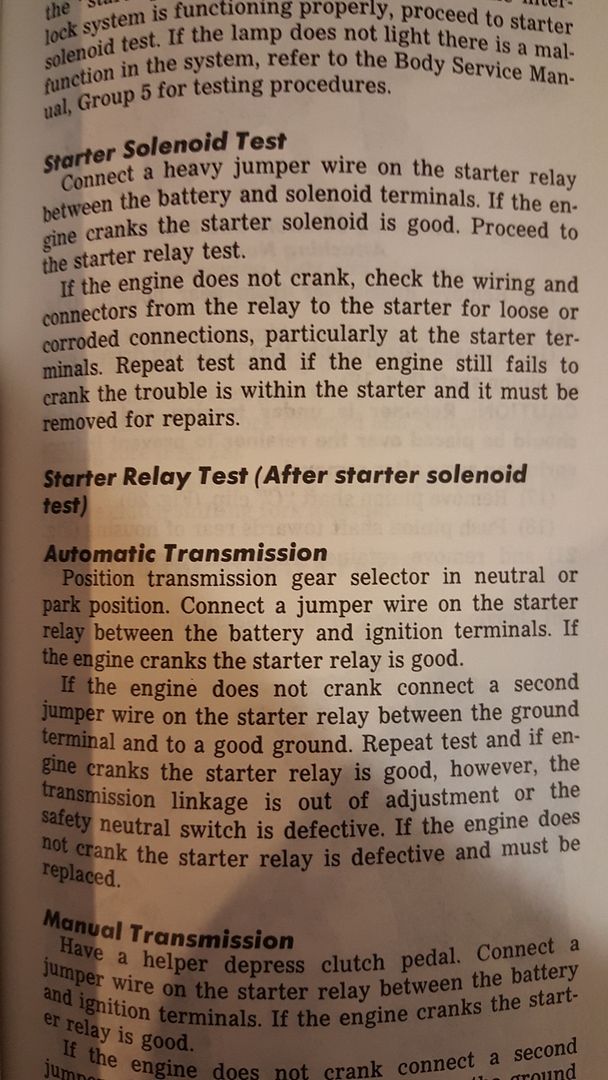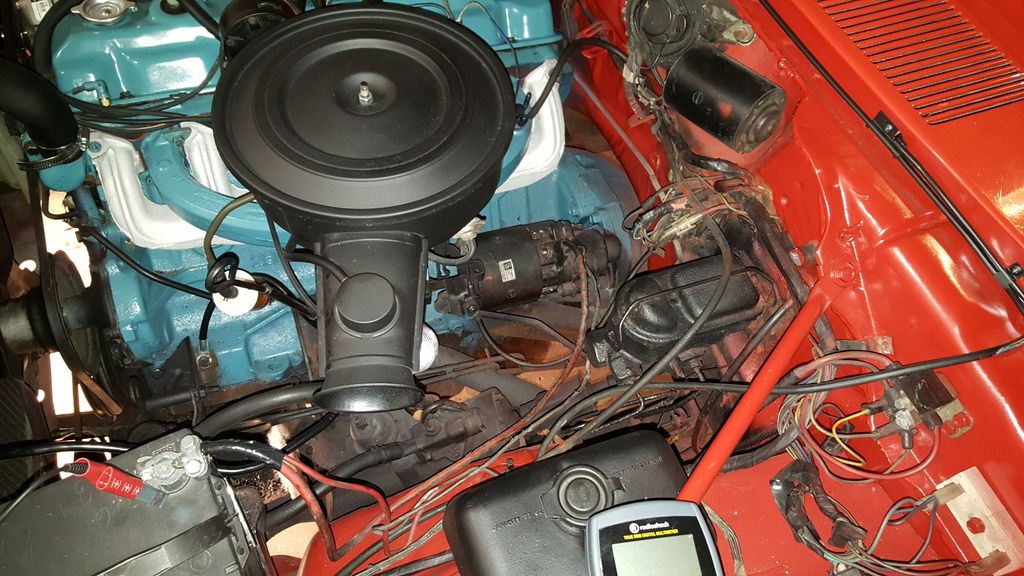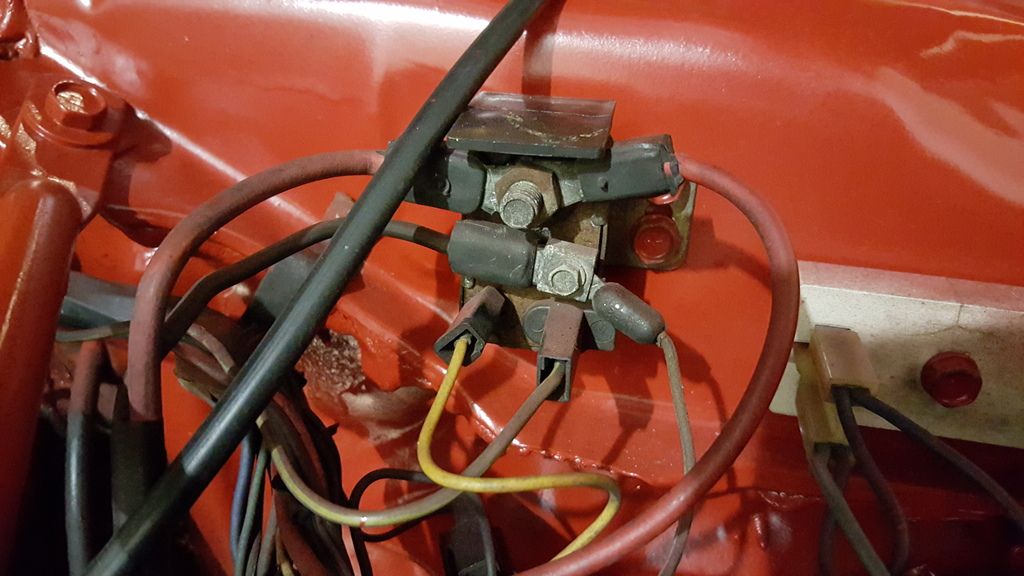Testing Starter
- Thread starter furyfrank
- Start date
-
You can't simulate the engine load(actual load),on a bench tester. Properly done,on the car.Depending o the amperage draw.Sling parts for a living. Seen several starters pass bench test.Means dicdidly.If possible, test on the car.
Voltage drop,with a load on it. The battery 12.2 volts,minimum. The battery ,should show 9.6 volts or better, during a test load or cranking. Cables,no more that.2 of a volt,with clean connections. This is 67 Darts forte,hang tight.
67Dart273
Well-Known Member
LOL. You CAN test them for "locked armature" draw, but this does not show anything about bearings, or drag between the field and armateur, etc.
When testing on the car, you have to keep several things in mind.................
The starter draws down the battery, so what?? affects that?
Condition of the starter, obviously. Worn bearings, dragging armature, field, bad brushes ---more current, less voltage.
But also battery condition .....lightweight or old battery .........less voltage
Poor cables.........voltage drop, small cables, etc, less voltage
Something wrong with the engine..........more drag...........more current draw..........less voltage.
But A Bomber is right a quick check is to check battery voltage under load. The right way to do this is to first charge the battery, get it "up," and load test the battery using a high current tester known as a "carbon pile".
Then you crank the starter a few seconds and watch battery voltage.
Then you draw down the battery voltage with the load tester to equal the battery voltage you got while cranking, and the ammeter on the load tester will show what the starter is actually drawing. Whatever is going on in this photo (probably a battery test) that ammeter is showing SEVEN HUNDRED amps!!!!

When testing on the car, you have to keep several things in mind.................
The starter draws down the battery, so what?? affects that?
Condition of the starter, obviously. Worn bearings, dragging armature, field, bad brushes ---more current, less voltage.
But also battery condition .....lightweight or old battery .........less voltage
Poor cables.........voltage drop, small cables, etc, less voltage
Something wrong with the engine..........more drag...........more current draw..........less voltage.
But A Bomber is right a quick check is to check battery voltage under load. The right way to do this is to first charge the battery, get it "up," and load test the battery using a high current tester known as a "carbon pile".
Then you crank the starter a few seconds and watch battery voltage.
Then you draw down the battery voltage with the load tester to equal the battery voltage you got while cranking, and the ammeter on the load tester will show what the starter is actually drawing. Whatever is going on in this photo (probably a battery test) that ammeter is showing SEVEN HUNDRED amps!!!!

Thank you. The VAT 40 analog,best weapon ever.
TylerW
Well-Known Member
The 'redneck" way..lol. Seriously though, the experience I have had with them is when they spin up good and take a long time to spin down, they will normally work fine on the car, such as the starter in this video did.
I've also pulled my hair out trying to solve why the bendix would kick out but the starter wouldn't spin. That was a bad connection at the battery terminal...one of those crappy replacements.
[ame="http://www.youtube.com/watch?v=e4PQVmVM53w"]How to test a starter with it off the vehicle - YouTube[/ame]
I've also pulled my hair out trying to solve why the bendix would kick out but the starter wouldn't spin. That was a bad connection at the battery terminal...one of those crappy replacements.
[ame="http://www.youtube.com/watch?v=e4PQVmVM53w"]How to test a starter with it off the vehicle - YouTube[/ame]
BillGrissom
Well-Known Member
Since we are talking slants, the best tester is the engine itself since it takes <5 min to swap out a slant starter, and you don't even get grubby. Get a mini-starter from a Magnum engine (Dodge truck or Jeep V-8 thru ~2000) and much easier. Don't fault the starter unless you measure >8 V across it while cranking, otherwise the battery & cables aren't doing their job.
Another thing while cranking the engine ( trying to start it ) after a while the positive battery cable gets very hot. I am thinking this might be normal or am I wrong. Some one put a viper alarm and the car has a extra fuse block on it. I am jumpering the car from the battery to the coil and the car has a pertronics ignition. I am trying to figure if I should try to figure the alarm or get it started..
67Dart273
Well-Known Member
How long is "cranking awhile?" I'd suspect a bad cable or bad cable connections.
The problem with a bad starter of course is that it will "amplify" other marginal stuff. If the battery is a little old, or a little on the light side, or if the cable clamps are marginal, or a little on the light gauge side, then a heavy starter draw will cause things like hot cables.
But the OTHER possibility is that the cable itself is the whole problem!!!
You have a multimeter? clip one lead to the starter stud, and stab the other end directly into the top of the battery post. Crank the engine (jumper the starter relay.) If you have a volt reading of more than about .3V (three tenths of one volt) either the battery clamp needs cleaned, the cable is bad, or both.
The problem with a bad starter of course is that it will "amplify" other marginal stuff. If the battery is a little old, or a little on the light side, or if the cable clamps are marginal, or a little on the light gauge side, then a heavy starter draw will cause things like hot cables.
But the OTHER possibility is that the cable itself is the whole problem!!!
You have a multimeter? clip one lead to the starter stud, and stab the other end directly into the top of the battery post. Crank the engine (jumper the starter relay.) If you have a volt reading of more than about .3V (three tenths of one volt) either the battery clamp needs cleaned, the cable is bad, or both.
SwingerLSX75
Well-Known Member
I'm having a similar issue on my 75 /6 swinger right now and when the issue began yesterday I felt the cables and they were warm/hot after trying to turn it over. I'm going to look into what 67Dart273 suggested In troubleshooting.
But I got this picture below right out of the service book. Is it just me or is it saying to do the same thing to test both?

But I got this picture below right out of the service book. Is it just me or is it saying to do the same thing to test both?

Read the above posts, it should help you eliminate the guesswork.
BillGrissom
Well-Known Member
YoungDart75,
How long did you crank? Any battery cables and starter will get hot after 30 sec of cranking. The resistance goes up w/ heat and they then work poorer. You need to let things cool off for 5 minutes before cranking again. If you keep at it you could melt your starter (before the battery runs out).
M-B diesels are the only engines I have run across where the starter and wiring is rated for continuous cranking. In northern Germany, it might take 1 min of cranking to start a diesel on a -20 C morning.
How long did you crank? Any battery cables and starter will get hot after 30 sec of cranking. The resistance goes up w/ heat and they then work poorer. You need to let things cool off for 5 minutes before cranking again. If you keep at it you could melt your starter (before the battery runs out).
M-B diesels are the only engines I have run across where the starter and wiring is rated for continuous cranking. In northern Germany, it might take 1 min of cranking to start a diesel on a -20 C morning.
AJ/FormS
68 Formua-S fastback clone 367/A833/GVod/3.55s
- Joined
- Jan 19, 2014
- Messages
- 26,213
- Reaction score
- 13,504
I have had success using the following method.Now, I warn you its not very scientific, but it will tell you what you need to know. When its 30 below outside, where your car is, even just bolting the starter up is a chore I dont relish.
So this was my test rig.
I clamped the starter HARD in a big vise, on a very heavy bench,by one of its ears.I connected a battery up to it using generous sized cables and clamps. I hooked my remote starter button up, so it was ready to spin up.
I then took a 2x2x24 stick of wood and jammed it on the drive and under/against the vise body, in such a way that I could put my body weight on that stick in an attempt to stall the drive.
Then with the remote in one hand, and the stick in the other, I went to it.As the starter speed came up, I tried to stall the motor out with the stick. It made a lot of noise, and the stick took a licking, but a bad starter showed up instantly.
BTW, at that time, I had near 2 dozen starters.I discovered that there were several different types of Chrysler starters in at least two different cases.Not all of those old starters were the same,even though they may look similar or even the same.
I rebuilt/reconditioned about 4,or 5, or 6 of them,IDK. That was in the late 90s or so.I think I may still have 1 or 2 left. I dont use those any more, now since the mini came to market.
So this was my test rig.
I clamped the starter HARD in a big vise, on a very heavy bench,by one of its ears.I connected a battery up to it using generous sized cables and clamps. I hooked my remote starter button up, so it was ready to spin up.
I then took a 2x2x24 stick of wood and jammed it on the drive and under/against the vise body, in such a way that I could put my body weight on that stick in an attempt to stall the drive.
Then with the remote in one hand, and the stick in the other, I went to it.As the starter speed came up, I tried to stall the motor out with the stick. It made a lot of noise, and the stick took a licking, but a bad starter showed up instantly.
BTW, at that time, I had near 2 dozen starters.I discovered that there were several different types of Chrysler starters in at least two different cases.Not all of those old starters were the same,even though they may look similar or even the same.
I rebuilt/reconditioned about 4,or 5, or 6 of them,IDK. That was in the late 90s or so.I think I may still have 1 or 2 left. I dont use those any more, now since the mini came to market.
I went through this with my nephew and the starter from his ford exploder. Starter had been tested 3 times at different part stores before he called me. I made it very simple for him. A starter laying loose, hit with proper voltage, should start with so much torque it will roll itself over. His bad starter would only begin to run and build rpm like most electric motors. Again not scientific, just general observation/clue.
SwingerLSX75
Well-Known Member
I haven't tested voltage anywhere during startup yet but I know the battery had good voltage, I have a brand new alternator and negative cable from the battery to the block. Now yesterday I did a less scientific trick my dad suggested( seemed to be what the manual ended up saying anyway). I put a screwdriver across the battery lead and the solenoid lead on the relay and the car tried to spin over once or twice but very very slowly. When I try to start with a key it spins over once real good and then begins to crawl very very slowly. Once I put the key in the ignition and turn it to accessories like I'm about to start I can put the multi-meter on the relay or battery and see the voltage almost start a countdown while the key is in acc position. The positive cable is rather old and the wire from the solenoid to the relay is just as old as well.

However now after reading the relay test it just clicked for me to know how to test it so im going to try that because using the steps in the book and jumpering the battery and solenoid terminals made it spin but it just didn't spin freely for very long.

So I jumpered the battery wire to the solenoid wire and it started spinning the motor up. I jumpered the battery wire to the ignition wire and it started spinning the motor up. I noticed something when jump starting it to make it home the other day that it wouldn't jump start when I had the cables hooked to the negative terminal on the battery, but when I move it to the chassis it fired right up. Also it died the frist time when I put it in drive, so i'm going to test the neutral safety switch now.

However now after reading the relay test it just clicked for me to know how to test it so im going to try that because using the steps in the book and jumpering the battery and solenoid terminals made it spin but it just didn't spin freely for very long.

So I jumpered the battery wire to the solenoid wire and it started spinning the motor up. I jumpered the battery wire to the ignition wire and it started spinning the motor up. I noticed something when jump starting it to make it home the other day that it wouldn't jump start when I had the cables hooked to the negative terminal on the battery, but when I move it to the chassis it fired right up. Also it died the frist time when I put it in drive, so i'm going to test the neutral safety switch now.
BillGrissom
Well-Known Member
The NSS won't kill the engine, it simply disables the starting circuit (via relay coil), the same as in my 1996 & 2002 Chryslers.
While cranking, measure the voltage from the big +12 V stud of the starter (red lead) to its case (blk lead). If <8 VDC, don't fault the starter. Sounds like you may have excessive voltage drop from engine block to BATT- post. From starter's case to BATT- should be <2 V drop while cranking.
Did you clean the battery posts (w/ brush meant for that, both sides) and spray anti-corrosion? That is a yearly chore for all cars where you live. We might go 3 yrs in drier CA. That battery cable repair terminal you have can also be a problem. Unbolt the clamp and see if there is a lot of green on the wire (copper oxide doesn't conduct electricity).
When you get another starter someday, the mini-starters for the Magnum V-8 engines interchange and save weight, size, and $$, plus more powerful.
While cranking, measure the voltage from the big +12 V stud of the starter (red lead) to its case (blk lead). If <8 VDC, don't fault the starter. Sounds like you may have excessive voltage drop from engine block to BATT- post. From starter's case to BATT- should be <2 V drop while cranking.
Did you clean the battery posts (w/ brush meant for that, both sides) and spray anti-corrosion? That is a yearly chore for all cars where you live. We might go 3 yrs in drier CA. That battery cable repair terminal you have can also be a problem. Unbolt the clamp and see if there is a lot of green on the wire (copper oxide doesn't conduct electricity).
When you get another starter someday, the mini-starters for the Magnum V-8 engines interchange and save weight, size, and $$, plus more powerful.
67Dart273
Well-Known Member
Without a voltmeter you might as well go out and shoot your guns into the night so to speak. "Shooting in the dark."
This could be as simple as a bad cable, a bad cable to battery post connection, or something else simple. SO DO SOME TESTS
Get your meter.
Might need two people.
1...Connect the meter to the BLOCK and to the LARGE starter post. Jumper the relay or the solenoid as you did earlier. WHILE the starter is cranking, note voltage. Should be at least 10v at very minimum, higher is better.
2...If voltage is low, stab your meter into the tops of the battery POSTS. Not the cable clamps, the battery POSTS. Repeat the test. If the voltage is now up and acceptable, now it's time to run down "where" you are losing voltage.
NOTE WHAT the two voltage readings were in 1 and 2. This gives you the "difference" that you are losing
Now clip one probe to the postive POST, and the remaining lead to the positive battery clamp. Jumper the solenoid. Any loss? about a tenth of a volt? That's OK.
Now with one probe on the battery post move the other probe to the starter big stud and repeat. More drop? How much? 3 tenths? barely acceptable. 4-5 tenths for more? Not acceptable. Remove the post / clamp, scrape clean , and retighten it and the nut on the starter, and retest. Improve? No? Replace the cable.
Do the same with ground. Start with probe on battery NEG post, the other probe on the clamp. Move the probe to the block. Same results as above, more than .3V or so, redo the connections, if no improvement, replace the ground cable.
THE BATTERY. If you get less than 10v when cranking AT THE battery posts, the battery is either discharged or defective. Charge it up. Retest. If no improvement, yank the battery out and go find someone with a BATTERY LOAD TESTER
IT DOES NOT matter if the battery is 100 years old or 1 minute old. Any battery can be 'defective.'
This could be as simple as a bad cable, a bad cable to battery post connection, or something else simple. SO DO SOME TESTS
Get your meter.
Might need two people.
1...Connect the meter to the BLOCK and to the LARGE starter post. Jumper the relay or the solenoid as you did earlier. WHILE the starter is cranking, note voltage. Should be at least 10v at very minimum, higher is better.
2...If voltage is low, stab your meter into the tops of the battery POSTS. Not the cable clamps, the battery POSTS. Repeat the test. If the voltage is now up and acceptable, now it's time to run down "where" you are losing voltage.
NOTE WHAT the two voltage readings were in 1 and 2. This gives you the "difference" that you are losing
Now clip one probe to the postive POST, and the remaining lead to the positive battery clamp. Jumper the solenoid. Any loss? about a tenth of a volt? That's OK.
Now with one probe on the battery post move the other probe to the starter big stud and repeat. More drop? How much? 3 tenths? barely acceptable. 4-5 tenths for more? Not acceptable. Remove the post / clamp, scrape clean , and retighten it and the nut on the starter, and retest. Improve? No? Replace the cable.
Do the same with ground. Start with probe on battery NEG post, the other probe on the clamp. Move the probe to the block. Same results as above, more than .3V or so, redo the connections, if no improvement, replace the ground cable.
THE BATTERY. If you get less than 10v when cranking AT THE battery posts, the battery is either discharged or defective. Charge it up. Retest. If no improvement, yank the battery out and go find someone with a BATTERY LOAD TESTER
IT DOES NOT matter if the battery is 100 years old or 1 minute old. Any battery can be 'defective.'
SwingerLSX75
Well-Known Member
I tried testing the continuity and it didn't read anything when testing the center pin to the transmission case. I tried clearing off a section of the housing as well and it still read nothing. Which the manual says check the linkage before you replace the switch.
The battery I have does have a cca rating on it and is from the previous owner. When I took it into advance they tested it and came up as 673 cca after I charged it up.
67Dart ill try some of those things tomorrow im all cleaned up for the night now and time to relax before work tomorrow. Thanks for the tips and help.
The battery I have does have a cca rating on it and is from the previous owner. When I took it into advance they tested it and came up as 673 cca after I charged it up.
67Dart ill try some of those things tomorrow im all cleaned up for the night now and time to relax before work tomorrow. Thanks for the tips and help.
SwingerLSX75
Well-Known Member
Without a voltmeter you might as well go out and shoot your guns into the night so to speak. "Shooting in the dark."
This could be as simple as a bad cable, a bad cable to battery post connection, or something else simple. SO DO SOME TESTS
Get your meter.
Might need two people.
1...Connect the meter to the BLOCK and to the LARGE starter post. Jumper the relay or the solenoid as you did earlier. WHILE the starter is cranking, note voltage. Should be at least 10v at very minimum, higher is better.
2...If voltage is low, stab your meter into the tops of the battery POSTS. Not the cable clamps, the battery POSTS. Repeat the test. If the voltage is now up and acceptable, now it's time to run down "where" you are losing voltage.
NOTE WHAT the two voltage readings were in 1 and 2. This gives you the "difference" that you are losing
Now clip one probe to the postive POST, and the remaining lead to the positive battery clamp. Jumper the solenoid. Any loss? about a tenth of a volt? That's OK.
Now with one probe on the battery post move the other probe to the starter big stud and repeat. More drop? How much? 3 tenths? barely acceptable. 4-5 tenths for more? Not acceptable. Remove the post / clamp, scrape clean , and retighten it and the nut on the starter, and retest. Improve? No? Replace the cable.
Do the same with ground. Start with probe on battery NEG post, the other probe on the clamp. Move the probe to the block. Same results as above, more than .3V or so, redo the connections, if no improvement, replace the ground cable.
THE BATTERY. If you get less than 10v when cranking AT THE battery posts, the battery is either discharged or defective. Charge it up. Retest. If no improvement, yank the battery out and go find someone with a BATTERY LOAD TESTER
IT DOES NOT matter if the battery is 100 years old or 1 minute old. Any battery can be 'defective.'
1. it read about 3.5-5.3 when jumpered here.
2. read right at about the same as step 1.
3. with one probe on the battery post and the other on the positive post battery clamp there was no loss when cranking.
4.With one probe on the positive battery post and the other one on the big start starter stud there was no more drop than from the previous test.
5. when testing the battery posts with the relay jumpered the battery drops to 3.4-5.5 volts which is the same as the reading from before. So right now im gonna pull the battery and take it in to get tested thoroughly.
Thanks for the help so far.
SwingerLSX75
Well-Known Member
Battery has been on a slow charger the last few days on and off during this whole process to ensure it was charged for the trouble shooting. It charges up to 12V just fine. This is why I took it in after I went through your steps and what I found out.
1. The battery is supposed to be a 690 CCA battery at full charge.
2. When tested at advance, after the 4 or 5 attempts at turning over the car during the trouble shooting it read "14" CCA. Yes only 14. After a few turns it shouldn't have dropped 676 CCA. So right now that's my most likely candidate.
1. The battery is supposed to be a 690 CCA battery at full charge.
2. When tested at advance, after the 4 or 5 attempts at turning over the car during the trouble shooting it read "14" CCA. Yes only 14. After a few turns it shouldn't have dropped 676 CCA. So right now that's my most likely candidate.
BillGrissom
Well-Known Member
When you tested #1, were your meter leads right on the battery posts? I mean right on the round lead terminals of the battery, not on the connecting terminals. If not, repeat. You can often loose 10 V going from post to terminal, which is why everybody sells battery brushes. You must remove the terminal to use the brush.
If you did #1 right, then the battery probably is bad. My tip-off is that when I put it on the charger (when wouldn't crank) and charger says "full" in <30 min @ 10 A, I know it "isn't holding a charge". Also, my "Battery Brain" has usually tripped a few times (see ebay). Autozone tests it and usually confirms "bad". Last 2 times it was a battery I bought just 6 mos earlier. Their gold-top rated, so free replacement. They said they got a batch of bad batteries in their new store, perhaps other stores slyly unloading old stock on the new guys.
If you did #1 right, then the battery probably is bad. My tip-off is that when I put it on the charger (when wouldn't crank) and charger says "full" in <30 min @ 10 A, I know it "isn't holding a charge". Also, my "Battery Brain" has usually tripped a few times (see ebay). Autozone tests it and usually confirms "bad". Last 2 times it was a battery I bought just 6 mos earlier. Their gold-top rated, so free replacement. They said they got a batch of bad batteries in their new store, perhaps other stores slyly unloading old stock on the new guys.
SwingerLSX75
Well-Known Member
When I did number 1 I had the negative on the block next to where the negative cable is bolted in, and the positive on the large bolt of the starter.
when I did step 2 I stabbed the lead into the top of the negative post on the battery and then had the positive on the large bolt of the starter.
when I did step 2 I stabbed the lead into the top of the negative post on the battery and then had the positive on the large bolt of the starter.
SwingerLSX75
Well-Known Member
Well after throwing the new battery in I decided to replace the cables and she fired up almost instantly. Thanks 67Dart for all the troubleshooting help. Definitely led me right to the problem.
-
















